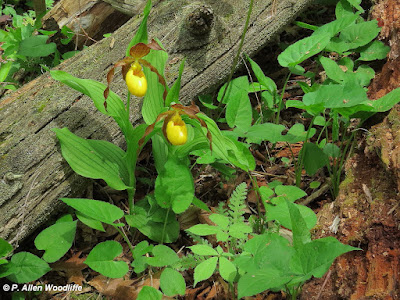Exploring natural areas is always a treat. I went out to check the Lake St. Clair area on a couple of occasions to try and get a glimpse of some of the American White Pelicans that have been seen. I came up empty with respect to the pelicans, but did see things like a pair of Sandhill Cranes near my viewing point.....
....as well as a nice male Yellow-headed Blackbird.But most of my wanderings have been in the Rondeau area, as usual, as it is one of the most interesting natural areas in the entire province.
The land bird migration has quietened, and those that are still passing through are harder to see due to leaves. But shorebirds and such are quite plentiful, and visible. Dunlin have been quite abundant.....
But sometimes they are only seen passing by.
These past few days are typically when the peak of Whimbrel pass through, and they have been pretty much on cue. I have seen them on several occasions, but never close enough to photograph, or in the best light, so I've delved into my photo archives for these next two photos.
Certainly one of the highlights of recent days was the presence of not one, but two, Piping Plovers. It is an endangered species, and are behaving like a mated pair, so perhaps an attempt at nesting will occur. If it does, it will be the first time in ~80 years.
I hope to have more to say on this event in the future, and hope it will be chock full of good news!
Aside from birds, there are other things to take note of and appreciate at this time of year. White Baneberry is starting to show itself in flower.
Violets are everywhere, with two of the more common ones being Long-spurred Violet, shown first...
...and Downy Yellow Violet.
Mayapple is widespread....
...although I'm not sure it shouldn't be called Juneapple, since the apple-like fruits don't typically appear until June.
The open sandy beach dunes have Hairy Puccoon popping up throughout.
I have a sort of favourite, quiet ridge to explore at least once or twice a year. It takes a bit of effort to get to, and is always fun, especially if one enjoys the solitude.
It is a ridge where several clusters of Large Yellow Lady's-slipper can be found. It is not a common orchid species at Rondeau, which is why this particular ridge is of interest.
This is one of the most familiar native orchids to many people. One of the extra special things I discovered as a result of this outing, was something I didn't notice until I got the images on the computer and started processing them. At the bottom of the photo above, and about in the middle, I noticed a single plant of American Ginseng. This is an endangered species, and it is a new location for it at Rondeau. Given the overall habitat of this site, it wasn't totally surprising, but certainly nice to find. It makes one wonder how many more special things have yet to be found at Rondeau. This location is probably at least 500 metres from any trail, so is certainly never explored except by me.
Another quite rare plant and officially a Species At Risk is Eastern Flowering Dogwood.
A very attractive small tree, native to Ontario but not to Rondeau, is Eastern Redbud. This has been planted on a cottage lot, and although not native to the park, is always a pleasant thing to see.
Also in the plant kingdom is Dryad's Saddle, a fungus that can take on different shapes, as these next two images illustrate.
Another fungus looking slightly similar is this next one, with a common name of Trainwrecker.
I don't often see this next one, Shaggy Mane, part of the Inky Caps group, until later in the summer. The one stem has already shown its Inky Cap appearance.
I've brought this next item to reader's attention before, but only in the last couple of years since I was not aware of its presence at Rondeau until the fall of 2019. It is known as Beech Leaf Disease, and while it looks a bit different later in the season with distinct black stripes in between the leaf veins, it is showing up in the newly forming leaves already.
American Beech is a dominant tree species at Rondeau, but with the widespread presence of it here, American Beech are already being hit hard, and some trees have died. I have seen very few beech trees without at least some leaves that have been affected, so the future of American Beech is not looking good. Hopefully it will fare better than trees like Ash species and Elms, where most of the mature ones of those species have died out.
Another problematic invasive species is Japanese Barberry, which is in peak flower right now. The berries will develop and be frequently eaten by birds, with the seeds being defecated out somewhere along the way. Barberry is present throughout much of the park.
Sorry to end this blog post with such problematic species, but that is the reality of the natural world!
If you would like to subscribe, or unsubscribe, to Nature Nuggets, send an email to prairietramper@gmail.com

































































